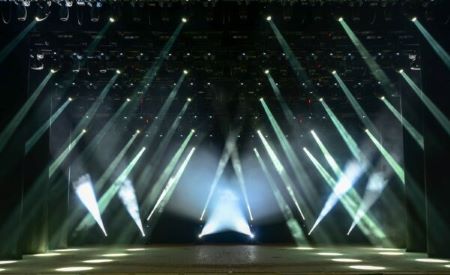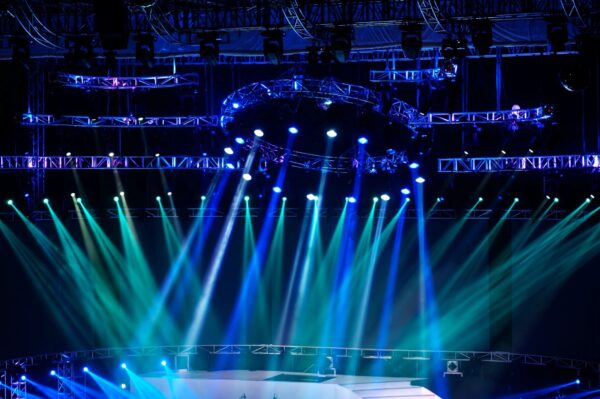The moment when the house lights dim, the stage blooms into a festival of colors and textures, and an electrifying energy pulses through the audience. Stage lighting can truly turn a performance into an experience. But do you know who’s behind this magic? Enter the electrician, a champion of connectivity and electricity, who illuminates the stage with creativity and precision.
The Role of an Electrician
As an electrician, your work is essential to every performance. Wiring sets up the stage for all light effects. Without your expertise, there would be no magic in a show.
Stage lighting electricians are responsible for everything related to lighting during a show. This involves designing the lighting plan, setting up fixtures, and operating controls during performances. They collaborate closely with other teams to ensure the lighting enhances rather than distracts from the actor’s performance.
Beyond creating dazzling effects, electricians also play a critical role in ensuring personal and fire safety on set. They’re charged with providing power supply without overloading circuits or risking power outages. Not to forget they’re your go-to persons when seeking installation help for specific equipment.
It’s no secret that this field is technically demanding. One must be adept at everything from understanding circuitry and voltage levels to manipulating color gels and LED fixtures. But don’t worry if these tasks seem daunting; resources like installation help are available to guide you through difficult installations.
The Art of Stage Lighting
The artistry of stage lighting fascinates me. Lighting can bent time, evoke emotions, and shape our perception of space. It’s involved in telling the story just as much as actors or the script.
Lighting can highlight an actor, set the mood, or even create illusions. It signals time or place changes and can provide visual clues to the audience. Electricians, therefore, need to be artists, intuitively understanding the director’s vision and translating it into something tangible.
Stage lighting also involves the creative application of scientific principles. Color theory is a key aspect of Lighting Design. An expert electrician must understand how different colors influence each other when overlaid or combined, and how they contribute to visual storytelling.
Remember, every technique that you apply serves an overarching purpose’”to deliver an immersive experience for the viewers. Perfecting this art requires practice, passion, and commitment.
Tools and Equipment Used
The realm of stage lighting is full of specialized tools and equipment. Luminaries, dimmers, control desks’”these are just some pieces of the proverbial puzzle known as LD (Lighting Design). LM (Light Meter) readings are integral too!
Luminaires or light fixtures come in multiple forms: from conventional lanterns to modern LED lights. Lighting control desks or consoles are where electricians operate the lights during a show. Lighting cues are programmed into these consoles during rehearsals.
Dimmers are crucial components that adjust light intensity. When integrated into a master system, these tools work together to paint pictures with light and shadows on stage.
In addition to these basic tools, there’s also a selection of secondary equipment. Smoke machines and mirror balls can amplify light effects, whilst safety gear like gloves and harnesses are imperative for hands-on tasks.
Stage Lighting Techniques
There’s a broad palette of lighting techniques each offering its own aesthetic effect. Knowing which ones to employ requires a deep understanding of light’s temperament and its influence on people’s perceptions.
Front lighting helps the audience clearly see the actor’s expression. While back and side lighting, create depth and drama. Top lighting emphasizes the shape of objects and figures on stage without revealing facial features.
High-key lighting floods the stage with light, often used for sitcoms or dance shows. In contrast, low-key lighting focuses light on particular areas, creating significant contrasting shadows. This technique is common in dramas or thrillers.
The ‘gobo’ technique projects patterns and shapes onto the stage adding another layer of visual texture. Imagine a forest scene: it’s your job as the electrician to twirl the gobos, calibrating light direction and intensity.
Electrician’s Safety Measures
Safety in stage lighting is paramount. Working with electricity is inherently risky. As an electrician, you play an instrumental role in maintaining safety standards on set.
The first safety measure involves maintaining all electrical devices regularly. Any minor issue can become a danger quickly if left untreated. Therefore, a proactive approach to equipment safety should be a part of your routine.
Each venue has specific load-in capacities. As an electrician, it’s crucial you understand these limitations while designing or implementing a lighting plan to prevent overloads and short-circuits.
Grounding all electrical equipment is another crucial safety measure; it can effectively reduce the risks of shocks. In case of overload or current leakage, this practice ensures electricity directs towards earth rather than harmful pathways such as a person or equipment.
Lastly, always wear safety gear! Personal protective equipment (PPE) such as insulated gloves or shoes should always be worn during installations or repairs. No masterpiece is worth injury!
Working with Lighting Designers
As an electrician, one of the essential roles you’ll play is collaborating closely with lighting designers (LDs). The LD conceptualizes the ‘how and where’ of light. They use their exceptional artistic vision to shape a script’s reality on stage. But it’s the electricians who bring this vision to life. Imagine the LD as a painter, and you, the one mixing, preparing their paints.
You’ll work together in pre-production: discussing and finalizing plans for the lighting design. Technical terms will come into play here– like Fade In or Fade Out (FI/FO) which are terms used to gradually increase or decrease light intensity seamlessly.
During rehearsals, both of you will solidify this plan into programmed cues on the control desk. This intricate dance of lights requires perfect sync between the LD and you; every cue should be timed and executed flawlessly. Any inconsistency may distract from the performance on stage.
Your working relationship with an LD is built on communication, understanding, and trust. Their creative genius combined with your technical finesse can truly make a spectacle that leaves the audience spellbound./p>
Maintaining Stage Lighting
Maintenance is another key responsibility of electricians in stage lighting. Like any other machinery, lamps, fixtures, dimmers — all need regular attention and care. Only with regular upkeep can these tools continue functioning optimally.
- The first measure involves visual inspection. Check for physical conditions such as frayed wires or broken components immediately before and after every show.
- Next is cleaning dust or dirt off fixtures and dimmers as it can cause overheating.
- Then comes bulb replacement in lamps once they have reached their lamp life expectancy.
Alongside these steps, routine electrical testing is necessary too. It will detect any underlying faults in the system early on. Any minor flicker or hiccup should be reported and resolved proactively.
Then there’s the aspect of keeping spares readily available. The unpredictable nature of live shows means you should always be prepared for a quick switch out if a piece of equipment fails.
Keeping a maintenance log can be your best ally when it comes to tracking and planning these maintenance activities. It’s tedious work but trust that these efforts save from major malfunctions during performances.
Technological Advancements in Lighting
The world of stage lighting has changed considerably over the years, thanks to technology. What began with footlights using candles and limelight has now transitioned to LED and intelligent moving lights (IMLs).
IMLs represent an innovative evolution in stage lighting technology. Unlike fixed conventional lights, these can move and change colors, allowing dynamic light patterns during performances. They’re also more energy-efficient–a crucial advantage in today’s climate-conscious world./p>
- LED fixtures have also transformed the field with their wide color spectrum and low heat output.
- Wireless DMX (Digital Multiplex) controllers have introduced drastically increased mobility, allowing for cable-free data transmission between consoles and fixtures.
- There’s also software that enables 3D visualizations of light plots before they are physically set up on stage.
Tech advancements like these open up new possibilities for creativity and efficiency in stage lighting. You can create more exciting designs while saving on energy consumption and reducing setup time.
Challenges Faced by Lighting Technicians
Becoming an electrician specialized in stage lighting is besides a passion, also about overcoming challenges. From troubleshooting faulty gear minutes before the curtain rises to meticulously drafting safety protocols, every day can present its trial.
Working under tight deadlines is something you’ll frequently face. Be it installing a lighting system overnight or adjusting to last-minute changes in scripts or sets, delivering your best under time constraints requires resilience.
The physical demands of this job can also be taxing. Lugging around heavy equipment and working at heights are all part of the game. One must keep themselves fit and ready for such strenuous tasks.
Another major challenge is staying updated with ever-evolving lighting technologies. With tech growing at lightning speed, dedicating time and resources to learning new tools or software is integral for your survival in this competitive field.
Professional Growth for Electricians
Stage lighting provides electricians a rewarding, albeit challenging, career path. Besides consistent on-the-job learning, it offers diverse opportunities for professional development where one can ascend from an apprentice to Lighting Director (LD).
To progress in this field, obtaining certifications like Certified Entertainment Electrician (CEE) can be beneficial. It validates your expertise in stage lighting and distinguishes you among potential employers./p>
Nurturing connections within the theater community is another way of enhancing career growth. Networking isn’t just about finding job opportunities; it’s also about sharing knowledge and learning from others’ experiences.
Finding your niche or specialization can provide yet another push to your career. You could focus on different types of stage productions’”like live concerts, drama plays, ballets’”and develop unique skills suited for each.
Lighting the Path
In conclusion, being a stage lighting electrician is all about illuminating magic into performances while ensuring safety and functionality behind the scenes. With a perfect blend of artistic understanding and electrical expertise, you become an instrumental component of theater productions. By embracing challenges and capitalizing on new technological advancements, you continue to bring art to life and maintain the enchantment of stage lighting.



